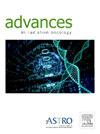Longitudinal Analyses and Predictive Factors of Radiation-Induced Lymphopenia After Postmastectomy Hypofractionated Radiation Therapy for Breast Cancer: A Pooled Cohort Study of 2 Prospective Trials
IF 2.7
Q3 ONCOLOGY
引用次数: 0
Abstract
Purpose
Radiation-induced lymphopenia (RIL) correlates with poor prognoses in solid tumors. This study aimed to investigate the post–radiation therapy (RT) longitudinal lymphocyte changes and the impact of different RT techniques on RIL in breast cancer patients.
Methods and Materials
We prospectively assessed 607 breast cancer patients who received hypofractionated postmastectomy RT in 8 hospitals. Radiation therapy techniques included integrated photon-based intensity modulated technique (integrated RT) and a combination of photon irradiation of supraclavicular nodes and electron irradiation of the chest wall and/or the internal mammary node (hybrid RT). Peripheral lymphocyte counts (PLC) were determined before RT, weekly during RT, at 1 and 2 weeks, 3 and 6 months post–RT, and then every 6 months. The primary outcome was the nadir PLC during RT, for which associated factors were analyzed. Univariate, multivariable linear regression and propensity score matching analyses were performed to evaluate the effect of different RT techniques on nadir PLC.
Results
During RT, 121 (19.9%) patients had grade ≥3 RIL with a nadir PLC of 0.75 ± 0.33 × 109/L. The PLC started to recover at 1 week and reached pre–RT levels 1 year after RT and higher than pre–RT levels 2 years later. Multivariate analysis identified young age, low body mass index, radiation therapy targets involving multiple regions, integrated RT, and low pre–radiation therapy PLC as independent risk factors for nadir PLC (P < .005). The PLC at each time point during and after radiation therapy was lower in patients receiving integrated RT than in those receiving hybrid RT (P < .05). Before and after propensity score matching, integrated RT was significantly associated with lower nadir PLC after adjusting for radiation therapy targets and age (P < .001).
Conclusions
Breast cancer patients had prolonged lymphopenia post–RT. Integrated RT increased the risk of RIL and adversely affected recovery. Therefore, an appropriate RT technique should be considered to minimize RIL.
乳腺癌乳房切除术后低分割放疗后放射诱导淋巴细胞减少的纵向分析和预测因素:2项前瞻性试验的合并队列研究
目的放射诱导淋巴细胞减少症(RIL)与实体瘤预后不良相关。本研究旨在探讨乳腺癌患者放疗后纵向淋巴细胞变化及不同放疗技术对RIL的影响。方法与材料我们对8家医院607例接受乳腺切除术后低分割放疗的乳腺癌患者进行前瞻性评估。放射治疗技术包括基于光子的综合强度调制技术(integrated RT)和锁骨上淋巴结的光子照射与胸壁和/或乳腺内淋巴结的电子照射相结合(hybrid RT)。外周血淋巴细胞计数(PLC)分别于放射治疗前、放射治疗中、放射治疗后1周、2周、3、6个月及每6个月检测一次。主要结果是RT期间最低的PLC,并对其相关因素进行分析。采用单变量、多变量线性回归和倾向评分匹配分析来评估不同RT技术对最低点PLC的影响。结果在RT期间,121例(19.9%)患者RIL≥3级,最低PLC为0.75±0.33 × 109/L。术后1周PLC开始恢复,术后1年达到术前水平,术后2年高于术前水平。多因素分析发现,年轻、低体重指数、涉及多区域的放疗目标、综合放疗和低放疗前PLC是最低点PLC的独立危险因素(P <;.005)。在放疗期间和放疗后的每个时间点,接受综合放疗的患者的PLC低于接受混合放疗的患者(P <;. 05)。倾向评分匹配前后,综合放疗与调整放疗目标和年龄后较低的最低点PLC显著相关(P <;措施)。结论乳腺癌患者放疗后淋巴细胞减少时间延长。综合放疗增加了RIL的风险,并对恢复产生不利影响。因此,应考虑适当的RT技术,以尽量减少RIL。
本文章由计算机程序翻译,如有差异,请以英文原文为准。
求助全文
约1分钟内获得全文
求助全文
来源期刊

Advances in Radiation Oncology
Medicine-Radiology, Nuclear Medicine and Imaging
CiteScore
4.60
自引率
4.30%
发文量
208
审稿时长
98 days
期刊介绍:
The purpose of Advances is to provide information for clinicians who use radiation therapy by publishing: Clinical trial reports and reanalyses. Basic science original reports. Manuscripts examining health services research, comparative and cost effectiveness research, and systematic reviews. Case reports documenting unusual problems and solutions. High quality multi and single institutional series, as well as other novel retrospective hypothesis generating series. Timely critical reviews on important topics in radiation oncology, such as side effects. Articles reporting the natural history of disease and patterns of failure, particularly as they relate to treatment volume delineation. Articles on safety and quality in radiation therapy. Essays on clinical experience. Articles on practice transformation in radiation oncology, in particular: Aspects of health policy that may impact the future practice of radiation oncology. How information technology, such as data analytics and systems innovations, will change radiation oncology practice. Articles on imaging as they relate to radiation therapy treatment.
 求助内容:
求助内容: 应助结果提醒方式:
应助结果提醒方式:


